March 27, 2008
Last week, the great Ed Catmull came to BYU to open the new BYU Center for Animation, a collaborative effort of the Engineering and Computing, Math and Something and Fine Arts colleges. Mr. Catmull is the president of Pixar, and also, incidentally, of Disney Animation. M saved me a seat. When he left the house, and he left early, I tried to explain to him how to weasel his way via hidden paths into the DeJong concert hall, in case they hadn’t opened the house by the time he’d gotten there. This is an arcane bit of knowledge not had many. Only us drama and vocal performance majors who have lived years in the basement of that building know the odd byways and accesses.
Mr. Catmull’s speech was more than interesting; as M is aimed straight at Pixar, I was interested to hear the man say that the most important aspect of building a creative institution that can last the day is finding great people and building functional teams. The company, it seems, has found valuing people its core concern. And of course, when you see Pixar movies you realize that every one of them speaks of the human journey and connection.
But the best part of the experience was the incredibly odd end part: M said, “Now, show me these secret ways into this place.” So I did, and found myself plunged into an old and forgotten life.
Three solid years (including summers) of my life as a student had centered on that building. I had spent several semesters working in the basement costume shop (to my mother’s chagrin; she never wanted us to have to work in college). In fact, I was in there sewing my heart out the day of my own graduation, which I had not deigned to attend. I met the man who would some day be our long-time studio piano tuner down in the piano lab (that’s an old friendship) next door down from that costume shop. I knew back dim stairways, hidden green rooms, arcane hallways the way you know your own house in full daylight. I taught labs in the Fine Arts photo lab when it was down there. I sang and danced in the echoing subterranean halls. I snuck into the organ practice rooms to play Bach (badly). Later, I taught a freshman English class in one of the make-up rooms off the tunnel.
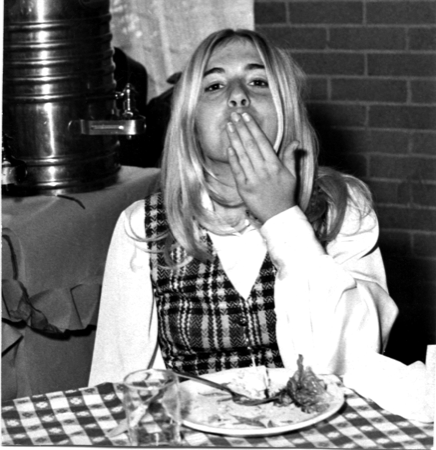
Okay, so in the spirit of things, I have hunted up the five or so shots taken of me
during my college years. Here, I am a freshman in a little fake Wilkensen Center French Cafe.
It was more than a stomping ground; for me, for so many years, the place was home, business, social life – everything. So I was more than glad to lead Murphy and friends into the labyrinth. At first, things went very well—I showed them the back staircase, the staging area off the side of the huge DeJong stage, the hallway below that lead to the costume shop. We explored the DeJong green room; the girls followed me into the women’s room where there are make-up mirrors and lockers and showers, and where, or so legend has it, the occasional odd insider, behind-the-scenes student will secretly live for months at a time.
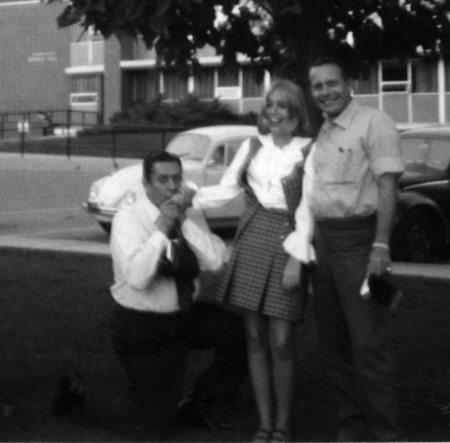
In front of my dorm with Dad and goofy family friends.
I told them about the orchestra pit – showed them the door you must never open, for fear of a terrible, squishing death – through it is the space under (or over, depending) the hydraulic pit floor – and while I was explaining it, the crew upstairs raised the floor right before our very eyes.
I was mysterious and romantic—a phantom of the opera, trailing M and his three female friends along in the shadow of my unfurling (and figurative) cloak.
Until I got lost.
I never, ever thought I could get lost down there. But I swear they’ve changed the halls around. The photo lab isn’t there anymore. But I KNOW the Pardoe green room still is, and I couldn’t find it for anything. I led the kids around and aoround – past the black box theater doors, past the off stage door for the Nelke experimental – but could not for the life of me find the one stage I’d spent the most time on.
I remember years ago, showing my parents, or G – I don’t remember who – around the tunnel. We got down to the end and walked into the backstage of the Pardoe. I knew every inch of the place. And I was showing it off like it was mine, when this stage hand walks up and says, “Sorry folks. Authorized people only back here.” And I was left just shy of saying, “Listen sonny—and who the heck are YOU?” But you really can’t have it both ways; I’d turned my back on that whole theater thing long before – before graduate school, really. It hadn’t been right for me.
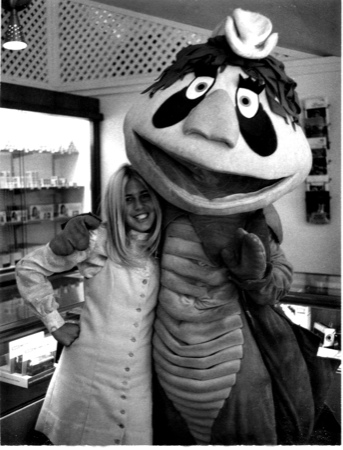
Here with HR Puffenstuff at my place of summer employment.
I made the dress. What there is of it.
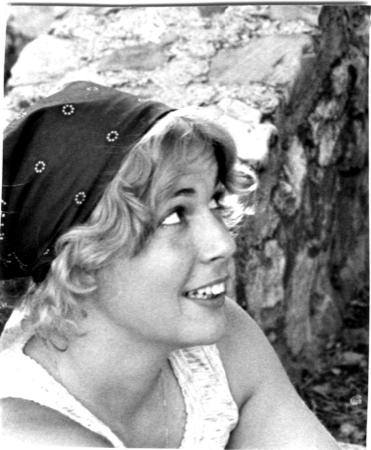
Me, in summer Shakespeare – about 1974
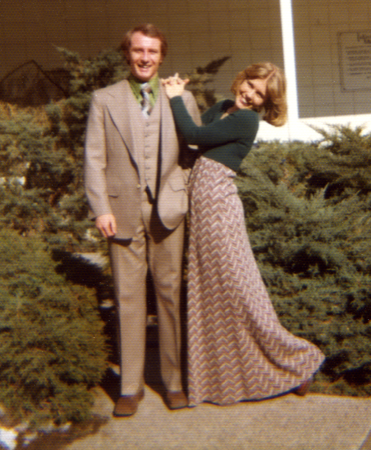
With the future bro-in-law 1974
Note the wand-slender youth. Me. That was me.
I do have this one marvelous story from those days: once, when I was a costume girl, the music department was staging Die Fledermaus. I think it was that one. Where we usually did all the costumes from the ground up, this production was huge and called for a massive number of fancy-dress period costumes. So we measured each one of the massive cast and sent off to Eve’s of New York for the costumes. Job done. Except, along came opening night, and the costumes hadn’t come. Suddenly, we were in panic mode – the costumer went through the back room, pulling anything and everything with a full skirt and the remotest similarity to the period of the show off the racks. The entire staff dumped classes, sleeping, food and disappeared in a flurry of alterations and improvisation—thread, fabric, scissors flying everywhere, industrial machines running like trains.
To me it was given to make the romantic lead’s second act opener – a blue dress, as I recall, and one that I sewed like the wind. I cut the thing out before the show had started, slammed the parts together, gathering waste and sleeves, all business while the first act was being played out somewhere over our heads. At intermission, the ingénue came down to us, and we threw the dress over her head, making last minute adjustments. The only thing missing? The back closure. No zipper. No buttons. So I pulled console through an emphatic needle and started to sew her into the dress.
We ran out of time.
Down the hallway she hurried, pulling me along by dent of the thread, and I was stitching on the very hoof. Up one flight of the back stairs – music swelling up above – up another, closing the back of the dress stitch by stitch as we went. Through the door onto the wings of the stage, and then right into the teasers I followed her – and snipped the thread in the very moment she stepped out into the spotlight and began to sing.
I hung there for just a second, poised between utter shadow and colored spot lights—regained my balance, stepped back. I had seen faces in the front row of the audience.
Through all of this, I had drawn no blood.

Note again—> the quizzical look.
Still got that one.


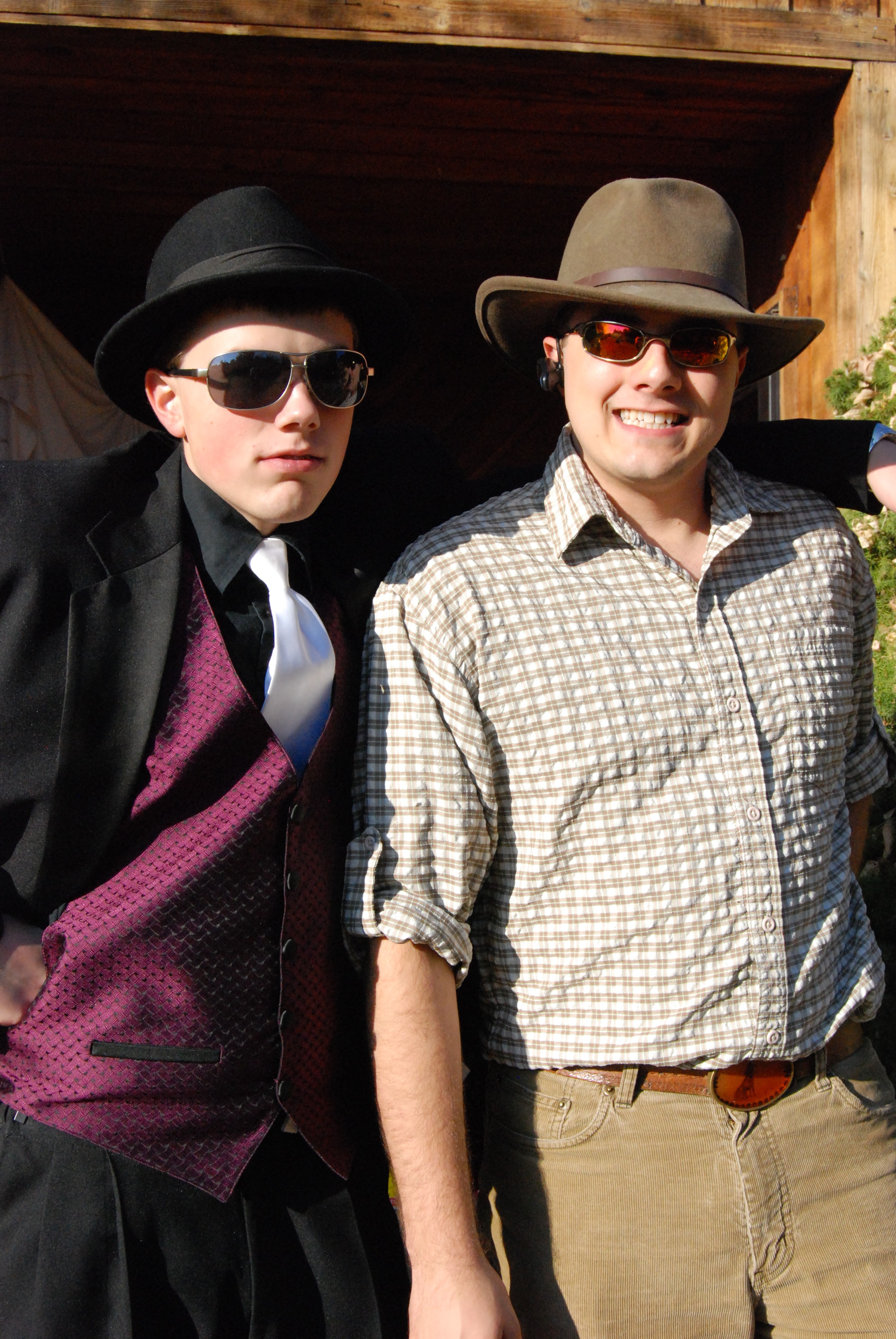
6 Responses to Stage Door Tales